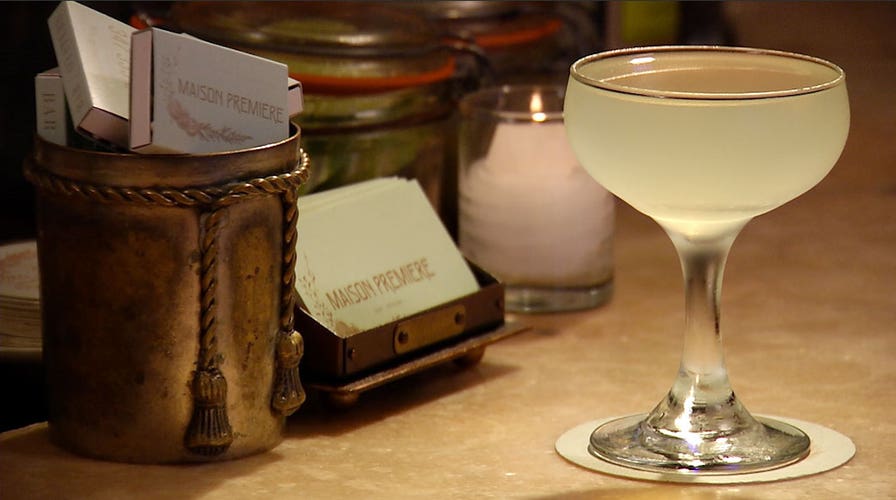Classic Absinthe Cocktail: Tuxedo No. 2
Brooklyn's Maison Premiere shows us how to make this once taboo absinthe cocktail.
Absinthe, sometimes called “the green fairy,” was the preferred high-proof drink among artists and writers in 19th century Europe before making its way to the States. And after subsequently being banned in the United States for nearly a century, absinthe has come roaring back to the bar scene.
“The rise of absinthe’s popularity coincided with the rising expense of purchasing wine, due to the Great French Wine Blight,” says Joe Pawelski, co-founder of Colorado-based Overland Distillery. "Though wine had been the drink of choice, economic complications caused consumers to turn to the cheaper alternative: absinthe."
But not everyone was a fan. According to "Hideous Absinthe," one French doctor characterized absinthe “as being distinguished by sudden delirium, epileptic attacks, vertigo, hallucinatory delirium more active and impulsive than with alcohol alone, and sometimes unconsciousness." Such claims were apparently bolstered by the fact that absinthe, which was infused with wormwood, contained a chemical called thujone, which was believed at the time to cause mind-altering effects.
Pawelski, however, says there's more to the story. "Those industries and parties wanting to dampen absinthe’s growing strength of popularity launched smear campaigns sighting absinthe’s supposed link to mayhem. When crimes were committed, absinthe was blamed. In short, it was proposed that absinthe made people crazy by altering their normal behaviors.”
On the strength of these campaigns, the U.S. banned the beverage in 1912, and it wasn't until 2007 that an absinthe recipe was developed to comply with the Alcohol and Tobacco Tax and Trade Bureau's new regulations that any absinthe with a verified thujone content of less than 10 milligrams per kilogram was acceptable.
Jared Gurfein, founder of Viridian Spirits, teamed up with chemist Ted Breaux to develop the recipe that met those requirements, and Viridian Spirits began selling Lucid Absinthe, legally, in the United States, on March 5th, 2007. The date soon became known as National Absinthe Day among social drinkers looking to channel their bohemian ancestors.
So, can this once forbidden fruit still induce mind-altering reactions after a few sips?
Dale DeGroff reveals in "The Essential Cocktail" that “contemporary chemists have proven wormwood and absinthe could not have been guilty of the crimes with which they were charged; more likely, the drinking problems in France were caused by the utter lack of regulation in the industry — and hence the dangerous byproducts that could be found in many distilled spirits — combined with absinthe’s very high proof.”
Anne-Louise Marquis, a New York City-based bartender and brand ambassador for Pernod Absinthe, says its myth is more fairytale than anything.
“All the talk about it being hallucinogenic is false,” says Marquis. “Thujone, the neurotoxic chemical in wormwood that everyone was convinced was causing insanity, actually appears in such small quantit[ies] that the FDA calls absinthe ‘thujone-free.’ There is more thujone in three leaves of sage than a whole bottle of absinthe," she adds. "[An] equal or greater amount of it appears in other spirits such as chartreuse and vermouth. The alcohol [in absinthe] will get to you before thujone ever will.”
Despite absinthe not being as potent as history once claimed, the spirit continues to inspire bartenders looking to create the perfect drink.
“It’s such a fun and fanciful category," says Kara Newman, spirits editor at Wine Enthusiast Magazine. "Over the past few years, we’ve had access to more absinthe bottlings than ever before, and they run the gamut from light, almost fennel-like flavors to big, bold licorice notes like Good & Plenty candies," she says.
“And my favorite reason? The growing array of absinthe-spiked cocktails,” Newman adds. “Absinthe provides an elusive flavor in drinks that’s impossible to replicate. What did we do before absinthe came back?”
Thinking of giving absinthe a try?
“Recognize that absinthe, with its characteristic anise flavor, may be an acquired taste," says John Mayer, the beverage director for Local 149 in Boston. "If you don't want to acquire this, no worries. Then you'll know that absinthe isn't for you. But if you choose to stick with a truly great bottle of absinthe, the reward is high, just not ‘a high.'”
In honor of National Absinthe Day, try celebrating with a Tuxedo No. 2, found at Maison Premiere in New York City. Watch the video above to see how it's made, then keep reading for the specifics.
Tuxedo No. 2 (Turf Club)
Ingredients:
- 3 dash orange bitters
- ¼ oz. Vieux Pontarlier Absinthe
- ½ oz. Luxardo Maraschino
- ¾ oz. dry vermouth
- 1¼ oz. Plymouth Gin
Method:
Combine all ingredients in a chilled mixing class. Fill with ice and stir, with a bar spoon, until well chilled. Strain into a coupe glass. Squeeze a lemon over the cocktail to release essential oils into the drink, and enjoy.

